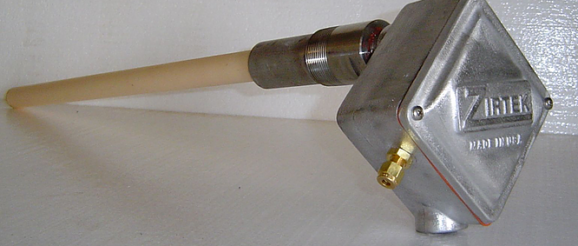In-Situ Oxygen Analyzers

The key element in combustion efficiency analysis is the accurate measurement of excess oxygen, with the measuring being done as close to the fire as possible. Oxygen measurement by zircronium oxide based sensors has been a preferred technique for some time, and the technology has proven to be highly reliable.
Accurate – Zirtek’s in-situ analyzer operates in the 1200 – 2900 F temperature range, making it possible to place the probe in the radiant zone adjacent to the combustion envelope. This minimizes errors which arise from tramp air (leakage), process lag and sampling issues ensuring measurement accuracy and stability.
Safe – The analyzer configuration consists of two assemblies, an intrinsically safe probe and powered electronics. The design makes meeting hazard classifications simple and cost effective by allowing the powered equipment to be placed outside the hazardous area.
Reliable – No calibration of the analyzer is required as the cells are guaranteed not to drift more than one percent (1%) of signal value over the life of the probe and the cell temperature variations are continuously corrected in the conversion algorithm. The Zirtek analyzer design, which does not use cell heaters and/or loading currents, provides the most cost effective, maintenance free, combustion measurement available.
LOCATION… LOCATION…. LOCATION!!!
For most combustion applications, the best available information is in the radiant zone near the flame front.
The characteristics of the In-situ method of measurement are preferable over designs using close-coupled, bypass or extraction configurations. The farther the sensor is from the point of interest, the more likely the measured value will be compromised.
Zirtek’s in-situ probe is designed to give the best available service for these applications.
| Reformers | Toxic Waste Incinerators | Coking Units |
| Crude Headers | Rotary Kilns | Thermal Oxidizers |
| Package Boilers | Process Heaters | Power Boilers |
| Fume Incinerators | Sulfur Recovery Units | Sludge Incinerators |
| Re-Melt Furnaces | Beehive Kilns | Hydrogen Plants |
The Probe:
In-situ measurement is a simple concept but can be difficult to implement in harsh, combustion conditions where dust, fly-ash, etc., can be prevalent. However Zirtek’s probe design is based on materials and techniques that have emerged from long service in the industry.
The Cell:
The sensing element of Zirtek’s probe is a cell manufactured from zirconium oxide substrate and platinum electrodes. The technology has been widely used for decades but implementation is the key to the successful application in industrial processes.
The Package:
Standard probe lengths are 18, 24, 30, 36 and 42 inches. The threaded (MNPT) mounting fittings are either 1 or 1.5 inch pipe size depending on the choice of sheath material. Standard sheath offerings are silicon carbide, alumina and high temperature alloys. The cable requirement for connecting the probe to the analyzer electronics is typical instrument cable having 2 twisted pair (4 conductors, copper-copper) with an overall shield. The run length, with 18 gauge copper wire, can be in excess of 1000 feet. A small quantity of dry, clean, ambient air is needed for the reference gas. The probe operates in an environment with a temperature range of 1125F to 2900F and nominal atmospheric pressure. Elevated pressure can be accommodated if necessary.
A key element in combustion efficiency analysis and control is the accurate measurement of excess oxygen.
Oxygen Measurement:
Measurement by Zirconium Oxide based sensors is and has been the preferred technique for several years. Zirtek’s ZKA Series analyzers incorporate proven technology and state of the art electronics to allow you to have the best available solution to combustion measurement. Expect more and get it with the wet measurement of excess oxygen in the radiant section of the combustion vessel.
The millivolt-level signals generated by the Zirconium Oxide cell and thermocouple are scanned by the high impedance, precision electronics Control Board (ZPERP-CB), where linearization and conversion to engineering units occurs. The input signals are used to calculate Volume Percent Oxygen using the Nernst Equation. The Oxygen and Temperature values are available as scaled, 4-20mA analog Outputs via terminations on the electronics board.
The Oxygen value, cell temperature and cell millivolt signal level are displayed on the HMI Home screen. The touchscreen Display Module (ZPAERP-DM) provides a user friendly analyzer interface for the operator.
Measurement in processes that operate from near stoichiometric to true fuel rich combustion conditions at temperatures above 625 C are challenging.
Combustibles Measurement:
Most analyzers, at the elevated temperatures, require sampling systems which are complex and require significant maintenance. They also still only provide inferred or empirical measurement of the actual combustion conditions.
Zirtek’s in-situ approach is based on Zirconium Oxide and measures Oxygen Depletion (Odel). Odel is a simple, direct solution to monitoring and control of zones with combustible components. Zirconium Oxide cells generate voltage proportional to the difference in the oxygen concentrations of the reference air and the combustion gas. As oxygen is depleted in the process atmosphere, the generated signal increases in magnitude. This characteristic along with tolerance for high temperatures makes zirconium technology a great choice for measurement in the reducing zones of fired processes.
Do you have an application you are considering? Please contact us at Memeco today and let us help you achieve your goals!
Email: info@memecosales.com Ph: 1-847-329-9393


Leave a comment